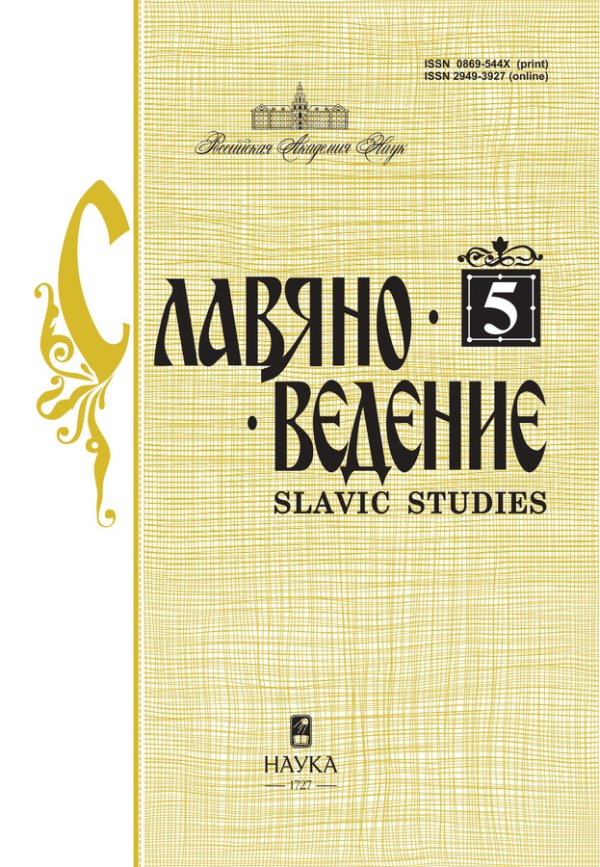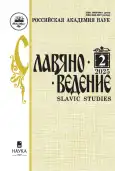Epiphanius Slavinetsky as a Translator of the Summaria Capitulorum in the Early Printed Liturgical Tetraevangelia
- Authors: Verner I.V.1
-
Affiliations:
- Institute of Slavic Studies of Russian Academy of Sciences
- Issue: No 2 (2025)
- Pages: 59-74
- Section: Articles
- URL: https://rjsvd.com/0869-544X/article/view/680822
- DOI: https://doi.org/10.31857/S0869544X25020052
- EDN: https://elibrary.ru/IZBGZK
- ID: 680822
Cite item
Abstract
The paper deals with the history of the emergence and spread of summaries (arguments) of the Gospel chapters in the editions of the Church Slavonic liturgical Tetraevangelia and the New Testaments from 1657 to the beginning of the 19th century. The emergence of this element of the biblical paratext is associated with the conversion of Moscow scribes to the practice of European book publishing of the early modern period. The only manuscript containing gospel summaries identical to the printed ones is the translation of the New Testament by Epiphanius Slavinetsky and Euthymius Chudovsky of the 1670–1680s. Linguistic analysis of the summaries allowed us to attribute their authorship to Epiphanius Slavinetsky. Lexical and word-formation features inherent to Epiphanius, as well as textual coincidences of the summaries with the translation of the New Testament by Epiphanius and Euthymius, are revealed. It has been established that the Church Slavonic arguments of the chapters reveal an obvious orientation toward the Latin summaries of the printed Greek editions of the second half of the 16th century. Epiphanius' summaries are not a literal translation from Latin, but a transformation of the Latin model, which presupposes both freedom of translation and of structuring of the summaries, which takes into account the features of the Slavonic text and its division into pericopes. Epiphanius' summaries have syntactic and stylistic originality (the word order that is atypical for the Church Slavonic, the combination of predicative and nominal constructions in the headings, the use of continuous multi-component headings and single-component predicative ones), and also reflect some linguistic traces of the Latin original.
Full Text
About the authors
Inna V. Verner
Institute of Slavic Studies of Russian Academy of Sciences
Author for correspondence.
Email: inna.verner@mail.ru
ORCID iD: 0000-0002-8385-3599
PhD (Philology), Senior Research Fellow
Russian Federation, MoscowReferences
- Aleksejev A.A. (ed). Slovar’ russkogo iazyka XVIII veka. Vyp. 20 (Planeta – Podniat’sia). St. Petersburg, Nauka Publ., 2013, 246 p. (In Russ.)
- Beliakova Je.V. K voprosu o perevode «Armenopula» na slavianskii iazyk v XVII v. Perevodchiki i perevody v Rossii do nachala XVIII stoletiia. Materialy 12 mezhdunarodnoi konferentsii «Kompleksnyi podkhod v izuchenii Drevnei Rusi» 11–15 sentiabria 2023 g., vyp. 3. Moscow, Institut rosssiiskoi istorii Rossiiskoi akademii nauk Publ., 2023, pp. 39–51. (In Russ.)
- De Bruyne D. Sommaires, Divisions et Rubriques de la Bible Latine. Namur, 1914, 601 p.
- Dovatur A.I. Et’jenny (Sem’ia filologov-izdatelei vo Frantsii XVI v.) Drevnii mir i my: klassicheskoje nasledije v Jevrope i Rossii, vyp. 1. St. Petersburg, Aleteiia Publ., 1997, pp. 70–79. (In Russ.)
- Gorskii A.V., Nevostrujev K.I. Opisanije slavianskikh rukopisei Moskovskoi Sinodal’noi biblioteki, otd. 2, ch. 1. Moscow, Sinodal’naia tipografiia Publ., 1857, 201 p. (In Russ.)
- Guseva A.A. Svod russkikh knig kirillovskoi pechati XVIII veka tipografii Moskvy i Sankt-Peterburga i universal’naia metodika ikh identifikatsii. Moscow, Indrik Publ., 2010, 1251 p. (In Russ.)
- Guseva A.A. Katalog izdanii kirillovskoi pechati 1801–1918 gg. iz sobraniia NIO redkikh knig (Muzeia knigi) Rossiiskoi gosudarstvennoi biblioteki, t. 1. Moscow, Indrik Publ., 2021, 462 p. (In Russ.)
- Horbury E. The Bible Abbreviated: Summaries in Early Modern English Bibles. Harvard Theological Review, 2019, 112/2, pp. 235–260.
- Kravetskii A.G. Ekstralingvisticheskije faktory v normalizatsii iazyka i teksta slavianskoi Biblii. Voprosy kul’tury rechi, t. 10, otv. red. A.D. Shmelev. Moscow, AST-Press Kniga Publ., 2010, pp. 403–407. (In Russ.)
- Nikolajeva N.G. Individual’noje nachalo v perevodcheskom tvorchestve Jepifaniia Slavinetskogo. Uchenyje zapiski Kazanskogo universiteta. Gumanitarnyje nauki, 2014, t. 156, kn. 5, pp. 30–39. (In Russ.)
- Ostapczuk J., Dzierżanowska B. Early Printed Editions of Cyrillic Liturgical Tetraevangelia. A Catalogue. Rocznik Teologiczny, 2023, LXV, z. 3, pp. 465–512. doi: 10.36124/rt.2023.18
- Ostapczuk J., Wysoczański W., Maciuszko J.T., Tofiluk J. Kratkie zhitiya evangelistov v kirillicheskikh staropechatnykh evangeliyakh tetr i ikh proiskhozhdenie (Short Lives of Evangelists in Early Cyrillic Printed Liturgical Tetraevangelions). Konštantínove listy, 2020, 13/1, pp. 126–143. doi: 10.17846/CL.2020.13.1.126–143.
- Pentkovskaia T.V. Novyi Zavet v perevode knizhnogo kruga Jepifaniia Slavinetskogo i pol’skaia perevodcheskaia traditsiia XVI v.: perevod argumentov k Apostolu. Russkii iazyk v nauchnom osveshchenii, 2016, no. 1(31), pp. 182–226. (In Russ.)
- Pentkovskaia T.V. Tolkovaniia na poslaniia apostola Pavla v perevode Jepifaniia Slavinetskogo kak istochnik Novogo Zaveta poslednei chetverti XVII v., Vestnik Moskovskogo universiteta, ser. 9: Filologiia, 2017, no. 2, pp. 27–52. (In Russ.)
- Podtergera I.A. Parateksty Ostrozhskoi Biblii: k lingvisticheskoi interpretatsii. Ostrozhskaia Bibliia i razvitije bibleiskoi traditsii u slavian: kollektivnaia monografiia, pod red. Je.A. Kuz’minovoi.Moscow, MAKS Press Publ., 2022, pp. 41–75. (In Russ.)
- Pokrovskii A. Biblioteka Moskovskoi Sinodal’noi tipografii, Ch. 2. Pechatnyje knigi. Vyp. 2. Inostrannyje knigi XVI v. (1539–1570). Opisal Aleksei Pokrovskii. Moscow, Sinodal’naia tipografiia Publ., 1912, 192 p. (In Russ.)
- Polnoje sobranije zakonov Rossiiskoi imperii. [Sobranije 1-je. S 1649 po 12 dekabria 1825 g.], t. 6: 1720–1722: [no. 3480–4136]. St Petersburg, Tipografiia 2-go Otdeleniia Sobstvennogo Je.I.V. kantseliarii Publ., 1830, 815 p. (In Russ.)
- Pypin A.I. Rossiiskoje bibleiskoje obshchestvo. 1812–1826. I. Osnovanije obshchestva i vneshniaia deiatel’nost’ jego do udaleniia kn. A.N. Golitsyna. Vestnik Jevropy, kn. 8, avgust 1868, pp. 639–716. (In Russ.)
- Verner I.V. K voprosu o jevropeiskikh istochnikakh perevoda Novogo Zaveta Jepifaniia Slavinetskogo i Jevfimiia Chudovskogo (1670–1680-je gg.): grecheskije rukopisi i pechatnyje izdaniia. Slověne, 2023, no. 12 (2), pp. 97–126. doi: 10.31168/2305-6754.2023.2.06 (In Russ.)
- Verner I.V. K voprosu ob avtorstve tserkovnoslavianskogo perevoda predisloviia k Frankfurtskoi Biblii 1597 g. i jego sud’be v polemicheskoi literature rubezha XVII‒XVIII vv. Slavianskii al’manakh, 2024, no. 3–4, pp. 102–131 DOI: (In Russ.)
- Voleková K., Svobodová A. (ed.). Staročeské biblické předmluvy. Praha, Scriptorium Publ., 2019, 623 p.
- Zapasko Ia.P., Isaievych Ia.D. Pam’iatky knyzhkovoho mystetstva. Kataloh strodrukiv, vydanykh na Ukraini, kn. 2, ch. 1 (1701–1764). L’viv: Vydavnytstvo pry L’vivs’komu universyteti Publ., 1984, 131 p. (In Ukr.)
Supplementary files











